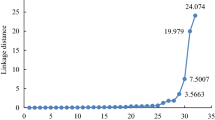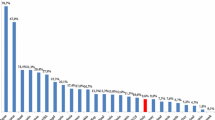Abstract
Based on a sample of ten of the country's 21public universities, this article examines therelative efficiency of South Africanuniversities between 1994 and 1997 using DataEnvelopment Analysis. After outlining thenature and limitations of the technique, aseries of seven models were tested. Each used aconsolidation of the annual output of graduatesand research as the output variable and testedthis against various input variables. A highdegree of consistency and stability was found.Differences in efficiency during the four yearperiod were studied and the article concludeswith a discussion of four factors which appearcentral in explaining differences in efficiencybetween universities.
Similar content being viewed by others
References
Athanassopoulos, A. and Shale, E. (1997). ‘Assessing the comparative efficiency of higher education institutions in the UK by means of data envelopment analysis’, Education Economics 5, 117–134.
Charnes, A., Cooper, W. and Rhodes, E. (1978). ‘Measuring the efficiency of decision making units’, European Journal of Operational Research 2, 429–444.
Charnes, A., Cooper,W., Lewin, A. and Seiford, L. (eds.) (1994). Data Envelopment Analysis: Theory, Methodology and Application. Boston: Kluwer Academic Press.
Charnes, A., Cooper,W., Wei, Q. and Huang, Z. (1989). ‘Cone ratio data envelopment analysis and multi-objective programming’, International Journal of Systems Science 20, 1099–1118.
Department of Education (1997). Education White Paper 3: A Programme for the Transformation of Higher Education. Pretoria: Department of Education.
Department of Education (2002). Transformation and Restructuring: A New Institutional Framework for Higher Education. Pretoria: Department of Education.
Emmanuel, C., Otley, D. and Merchant, K. (1990). Accounting for Management Control. London: Thomson Business Press.
Farrell, M. (1957). ‘The measurement of productive efficiency’, Journal of the Royal Statistical Society, Series A 120, 253–281.
Otley, D. (1988). ‘The contingency theory of organisational control’, in Thompson, S. and Wright, M. (eds.), Internal Organisation, Efficiency and Profit. Oxford: Philip Allan.
Taylor, B. (2000). Performance Measurement in Not-for-Profit Public Organisations: Relative Efficiency among South African Public Universities. Ph.D. thesis, University of Natal, Durban.
Taylor, B. and Harris, G. (2002). ‘The efficiency of South African universities: A study based on the analytical review technique’, South African Journal of Higher Education 16, 183–192.
Worthington, A. (2001). ‘An empirical survey of frontier efficiency measurement techniques in education’, Education Economics 9, 245–268.
Author information
Authors and Affiliations
Corresponding author
Rights and permissions
About this article
Cite this article
Taylor, B., Harris, G. Relative efficiency among South African universities: A data envelopment analysis. Higher Education 47, 73–89 (2004). https://doi.org/10.1023/B:HIGH.0000009805.98400.4d
Issue Date:
DOI: https://doi.org/10.1023/B:HIGH.0000009805.98400.4d




